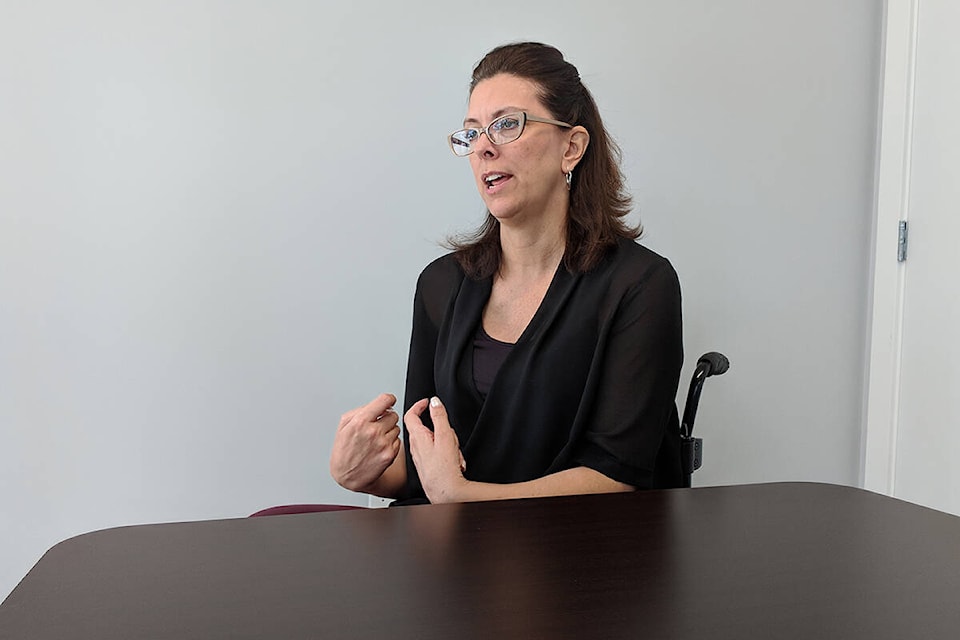If at first you don’t succeed, try, try – and try – again.
That’s the case with Surrey South MLA Stephanie Cadieux, BC Liberal Critic for Gender Equity, Inclusion and Accessibility, who on Nov. 16 introduced new legislation, as an opposition member’s bill, that would require developers to consider accessibility when creating new housing projects.
Cadieux, who has used a wheelchair ever since being involved in car accident at age 18, said she is determined to keep the issue in front of provincial politicians even though her current attempt – the Building Amendment Act, 2021 – marks the fourth time she has introduced such legislation in Victoria.
While the act may not become law, she said, it serves notice to the government that housing accessibility is something that needs to be addressed sooner rather than later.
One of the things that has hindered such legislation gaining enough momentum to date, she agreed – in a recent conversation with The Peace Arch News – is that it sounds so eminently reasonable that many assume such laws are already in place.
Those with disabilities know it is not the case, she said.
Finding accommodation is hard enough, she noted, but accommodation planned with the disabled in mind – or that is even adaptable to the widely varied needs of the mobility-challenged – is virtually non-existent.
In her speech introducing the act, Cadieux pointed out that “nearly 25 per cent of B.C.’s population identifies as having a disability – and the population of people with disabilities is growing at nearly twice the rate of the non-disabled population.”
“The problem is we aren’t planning for it.”
Her legislation would require that “all new multi-unit housing built would consider accessibility, and that a percentage of all new housing would be required to meet the criteria of either ‘adaptable,’ ‘visitable,’ or ‘accessible,’” she said.
An American housing survey conducted in 2011 found that less than one per cent of housing on the market would be considered accessible, and Cadieux told MLAs that, while she has not seen a similar Canadian survey, she would argue that figures for this country would be comparable.
“Of the thousands built in my constituency, alone, nothing is accessible, except for the odd condo development, where nothing is even remotely adaptable.”
READ ALSO: Stephanie Cadieux speaks out on need for accessible housing
READ ALSO: Opinion: In anticipation of a BC Accessibility Act
Cadieux pointed out that while the B.C. legislature recently unanimously passed accessibility legislation, such specific issues have not been contemplated and that, while the government has also launched a consultation on the building code, it has not issued any binding requirements.
“While standards are available, we have made the use of them optional,” she said. “We need to ensure an accessibility lens is applied when considering building for the future in all housing types; social, rental, single-family, condos and townhomes.”
Cadieux told PAN there are multiple issues standing in the way of progress in this matter – one of them a certain intransigence on the part of the development industry.
“Many, many developers have told me they believe it’s a very expensive thing to do. It’s not – but there’s a mindset that’s hard to shift. It’s a chicken-or-egg thing – developers have told me ‘we would build it if there was a market for it.’ To which I answer, ‘I would buy it if there was a product.’”
There are some simple things that can be done that would allow modification, Cadieux said, adding that the Safer House Society has estimated that the additional design costs involved would be only around $1,000 per development.
Cadieux acknowledged that while her bill received applause from both sides of the house – “Nobody will say no to something that makes sense” – the reality is that it is not likely to gain much traction with the NDP government without a great deal of popular support.
“The challenge for me is that I had gotten the support of my colleagues (in the BC Liberal government) for this prior to the 2017 election,” she noted.
But putting forward legislation, as she has done once again, is valuable even if only for the purposes of argument, she said.
“The purpose of putting it on paper is to remind the government that it is a problem and that a solution is proposed,” she said.
“The public could demand it by writing their elected members and saying, why don’t we have it,” she said.
The logical response to her action would be for the government to introduce their own bill, Cadieux said.
“The government could make it a priority by proposing their own legislation.”
“It would probably be quite different,” she said, noting the NDP’s current insistence that accessibility provisions be tied to a review of provincial building codes.
She said she feels that is the wrong direction for change.
Too often, those writing building code provisions have no clear understanding about the needs of the disabled population, she said, and are often prey to misconceptions of what makes a building truly accessible – focusing on access to suites alone, for example, without looking at the provision of adequate parking for disabled needs.
“But we’re not going to get there if we’re if we’re not talking about it and engaging and having an active conversation,” she said.
“I’m hoping that the government will also see fit to move in this direction.”
alex.browne@peacearchnews.com
Like us on Facebook and follow us on Twitter
